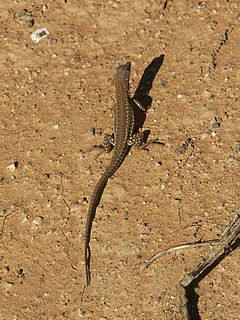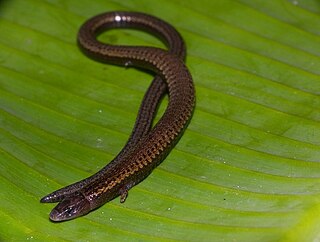
The Lacertidae are the family of the wall lizards, true lizards, or sometimes simply lacertas, which are native to Europe, Africa, and Asia. The group includes the genus Lacerta, which contains some of the most commonly seen lizard species in Europe. It is a diverse family with at least 300 species in 39 genera.

Typhlosaurus is a genus of African lizards, one of a number of genera of limbless lizards in the skink family (Scincidae). This group was recently revised with most species formerly attributed to Typhlosaurus now placed in Acontias. The current definition of Typhlosaurus includes five attenuate body legless lizards from southwestern Africa. This is the sister genus to Acontias, which together form the well supported Afrotropical subfamily Acontinae.

Eremias is a genus of lizards in the family Lacertidae, the wall lizards. They are native to Asia and southeastern Europe, where they live in desert and steppe regions.

Ichnotropis is a genus of African lizards in the family Lacertidae. Species in the genus Ichnotropis are commonly called rough-scaled lizards.

Lacerta is a genus of lizards of the family Lacertidae.

Meroles is a genus of lizards, commonly known as desert lizards, in the family Lacertidae. The genus contains eight species, inhabiting southwestern Africa, especially the Namib Desert.

Nucras is a genus of African lacertid lizards, commonly called sandveld lizards.

Tropidosaura is a genus of wall lizards of the family Lacertidae. The genus is endemic to southern Africa.

Bachia is a genus of lizards that belong to the spectacled lizards family.

The sand lizard is a lacertid lizard distributed across most of Europe including Britain, France, Belgium, the Netherlands, Denmark, southern Sweden, Germany, Austria, Slovenia, Romania, Croatia, Bosnia and Herzegovina, Serbia, Montenegro, Macedonia, Albania, Kosovo, Hungary, Czech Republic, Slovakia, Poland, Ukraine, Belarus, Western Russia and eastwards to Mongolia and northwest China. It does not occur in the Iberian peninsula or European Turkey. Its distribution is often patchy.

The viviparous lizard, or common lizard,, is a Eurasian lizard. It lives farther north than any other species of non-marine reptile, and most populations are viviparous, rather than laying eggs as most other lizards do. It is the only species in the monotypic genus Zootoca. Both "Zootoca" and "vivipara" mean "live birth," in Greek and Latin respectively. It was called Lacerta vivipara until the genus Lacerta was split into nine genera in 2007 by Arnold, Arribas & Carranza.

The Iberian rock lizard is a species of lizard in the family Lacertidae. The species is endemic to Portugal and Spain. Its natural habitats are mountain forests, shrubland, rivers and rocky areas. It is threatened by habitat loss.
The Atlas dwarf lizard is the only species in the genus Atlantolacerta, a genus in the wall lizard family, Lacertidae.
Phoenicolacerta kulzeri is a species of lizard in the family Lacertidae. The species is endemic to Western Asia.

Meroles squamulosa is a species of African lizard originally placed in the genus Ichnotropis, however phylogenetic evidence moves this species to the genus Meroles. The species is commonly called the common rough-scaled lizard or savanna lizard. It is largely found in southern Africa. These lizards are terrestrial and found in the range of mesic savannah. The common rough-scaled lizard is medium in size and well distributed in parts of Namibia, Botswana, Zimbabwe, Angola, Tanzania, and Zambia.
Dinarolacerta montenegrina, or Prokletije rock lizard, is a species of lizard in the family Lacertidae. It is found in Montenegro and Albania. It was first described in 2007. It differs genetically and morphologically from the most closely related species, Dinarolacerta mosorensis: in the exterior morphology, it is smaller; it has only one postnasal scale on one or both sides of its head; it has fewer temporal and postocular scales. The skeleton differs from D. mosorensis by its reduced supraocular osteoderms and the absence of an anteromedial process on the postocular bone.
Darevskia steineri, also known commonly as Steiner's lizard, is a species of lizard in the family Lacertidae. The species is endemic to Iran.

Darevskia valentini, also known commonly as the Caucasian rock lizard or Valentin's lizard, is a species of lizard in the family Lacertidae. The species is native to southeastern Europe and western Asia. There are three recognized subspecies.
Edwin Nicholas "Nick" Arnold, is a British herpetologist and former Curator of Herpetology at the Natural History Museum, London. Arnold made seminal contributions to the herpetology of Europe and North Africa, especially on geckos and lizards of the family Lacertidae. He discovered and described 36 species and 4 subspecies of reptiles, and wrote A Field Guide to the Reptiles and Amphibians of Britain and Europe, which appeared over multiple editions.














